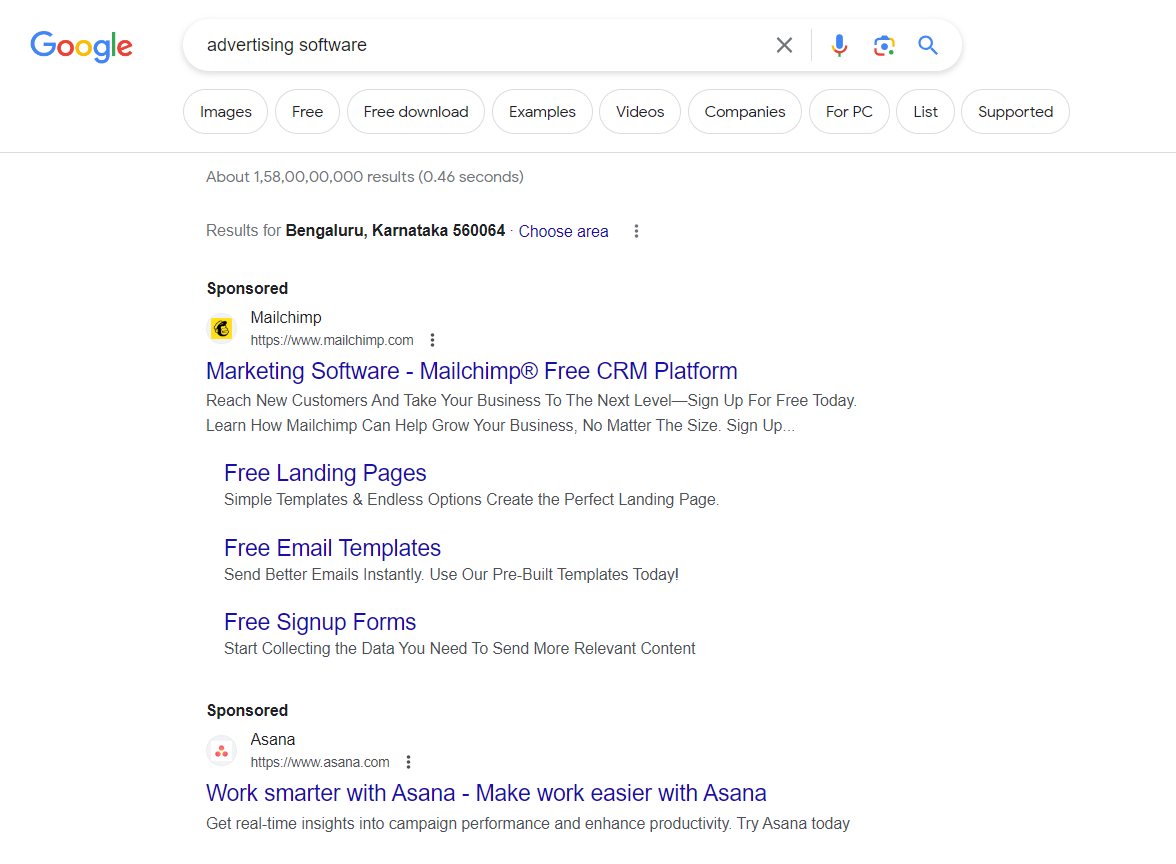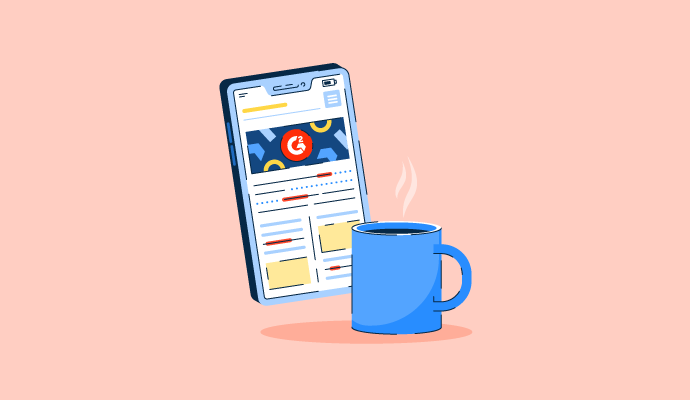There are a lot of different ways to advertise your brand and product.
Despite the array of choices available, all types of advertising share two mutual goals: to influence consumers and convert them into customers or leads.
When creating an impactful advertising campaign, no matter the platform, advertisers have a method to their madness that includes research, strategy, and cross-channel advertising software.
That madness can be overwhelming, but it can also be lessened by categorizing the types of advertising that you and your company will be participating in. Understanding your options is important to do this.
Types of advertising
The two types of advertising, digital and traditional, can be further segregated into the following types:
- Paid search advertising
- Social media advertising
- Native advertising
- Display advertising
- Mobile advertising
- Search engine advertising
- Direct mail advertising
- Print advertising
- Broadcast advertising
- Out-of-home (OOH) advertising
Advertising has a surprisingly long history, evolving from ancient cave paintings to the targeted ads that pop up on social media today. Let's explore the different types that have shaped the consumer landscape.
Digital advertising vs. traditional advertising
Before we begin, it's important that we understand the two larger categories of advertising: digital and traditional.
.png)
Digital advertising can reach a wide audience in a variety of different ways by harnessing the all-powerful internet and can also be customized to narrow down an audience by their demographics.
Traditional advertising focuses largely on what you'd think of when you think of "typical" advertising: television, radio, newspaper, magazine, direct mail, and billboard designs. This type of advertising reaches an enormous audience. This is great because it means that more people are seeing your advertisement, but it's hard to know whether or not the right people are seeing them.
The type of advertising you and your company choose should align with your ideal customer profile and work to engage with them often. In addition, the method you choose should be cost-effective and make sense with the product or service you're advertising.
Vous voulez en savoir plus sur Logiciel de publicité intercanal ? Découvrez les produits Publicité transcanal.
Digital advertising
In today's consumer culture, investing in digital advertising is a necessity.
Digital advertising relies on the internet to deliver promotional materials to customers and more curated audiences. Advertisers can receive results immediately regarding who has engaged with the advertisement, how that person engaged, and whether or not it led to a sale.
There are several types of online advertising that professionals can use to place advertisements and campaigns for an Internet audience.
Paid search advertising
Paid search advertising involves bidding on keywords so that advertisements related to specific keywords are placed at the top of the search engine results page (SERP). With paid search, advertisers only pay when their advertisement is clicked, providing the alter-ego pay-per-click (PPC).

Paid search is targeted, efficient, measurable, simple, and cost-effective. What more could an advertiser ask for?
Social media advertising
Social media advertising serves promotions via social media platforms. Advertising on social media gives you a quick return on investment (ROI) because everything on social is done in real-time. With UTM codes, you can track exactly where your sales are coming from when you tag your social media advertisements as such.
Social media advertising allows for a little more freedom to release a brand's personality, as social media tend to be a more relaxed platform than a paid search advertisement or a television commercial.
When advertising on social media, it's important to choose your platforms wisely and recognize that not everyone in your audience uses every platform. For example, your audience on Instagram is likely to differ from your audience on LinkedIn. Who are you trying to reach?
Social media advertising can be done organically and successfully if your audience is loyal and large, but if you're just starting out or looking to reach someone new, paying for advertisements will help you reach your potential.

With social ads, there's an added bonus--effectiveness is measured in real-time. Every piece of social media content that a business posts is trackable, so advertisers are able to collect insight on how much traffic an ad has, how many conversions it cultivated, and even who has engaged with the advertisement.
Native advertising
Banners and pop-up advertisements make it obvious that they're trying to sell you something. Native advertising camouflages itself.
By appearing as an almost-perfect match to the content that surrounds it, native advertisements come in the form of articles or videos on websites that are already hosting similar materials.
Great native advertisements provide consumers with valuable information and make the advertising aspect secondary to the message being communicated. Since they match the natural flow of the page, native ads are non-disruptive, and users won't feel like they're engaging with an ad.
The placement of native ads should be strategic and should also follow the patterns and interests of a business's target audience. Native advertising is labeled to alert readers that the content is sponsored, but the label is so discreet that it's brought up conflict among advertisers and readers.
Display advertising
In style and format, display advertisements are unmistakably selling you something. The obvious nature of display ads is a unique factor within the field of digital advertising since ads are typically implemented subtly.
Display advertisements can be designed to be animated or stagnant and are typically found along the top or sides of web pages. Display ads aim for quick conversions and their potential reach is enormous because search engines can match an ad with millions of websites based on keyword and targeting preferences. They typically look something like this:
Display advertisements are extremely prevalent online, which can damage their effectiveness. Because they provide no value to consumers other than a call-to-action, users have learned to ignore display ads, and click-through rates fall.
While display ads are not as popular as they once were, businesses should not completely ignore them in their ad campaign strategy. When display ads are direct and visually stimulating, they can grab the attention of an audience.
Mobile advertising
With the increasing number of mobile users, mobile advertising is one of the best ways for businesses to reach potential customers. This type of advertising is specifically designed for mobile devices like smartphones and tablets and can include text ads, banner ads, video ads, and native advertising.
Like any advertising, the goal of mobile advertising is to get customers to take the desired action. This could be anything from purchasing a product to signing up for a service or simply remembering a brand.
Search engine advertising
If you're looking for a way to drive more qualified traffic to your website, search engine advertising is a powerful tool to consider. It involves paying for ads to appear on search engine results pages (SERPs). When someone searches for a product or service using relevant keywords, your ad will appear alongside the organic search results.
Search engine advertising can significantly boost your website's visibility in search results, especially for competitive keywords where ranking organically might be difficult. You can also target your ads to a specific audience based on demographics, interests, and search queries.

Get the hottest marketing tea from G2.
Keep up with what’s really going down in marketing with the G2 Tea newsletter. Subscribe here
Traditional advertising
While digital advertising is becoming increasingly popular, traditional advertising isn't showing any signs of stopping. With the right budget and purpose in mind, traditional types of advertising can be just as effective as digital. Traditional advertising refers to delivering promotional messages through mass media.
Direct mail advertising
Direct mail advertising helps businesses reach potential customers by sending promotional materials through the postal service. These materials can take many physical forms, including brochures, catalogs, postcards, and even personalized letters. These physical ads can stand out more than digital advertising and can be more engaging for some people.
Direct mail also allows businesses to target specific demographics or geographic locations, making it a more precise way to reach potential customers than some other advertising methods.
While the field of advertising has evolved, the goals have remained the same: to influence the opinions and buying decisions of consumers. Advertising through print media was once the dominant form of advertising. Today, it exists among the millions of digital advertisements, and it's just as important.
Print advertising includes advertisements in
- Newspapers and magazines
- Brochures
- Directories
- Flyers and posters
- Direct mail (postcards and letters)
Understanding your audience and your own business is crucial when making the decision regarding whether or not you'll be using print advertising. What age group are you advertising to? Is the message something we can all understand, or is it local?
Broadcast
Broadcast advertising is sharing promotional messages about your product or service via television or radio. This type of advertisement is a risky investment, considering how easy it's been made for us to skip or change the channel completely.
Infomercials, network spots, national spot advertising, local spot advertising, and public service announcements are all forms of broadcast advertising. While broadcast is not the marketing tool that it once was, it has not reached a point of complete extinction, either.
For companies with a larger budget, buying a broadcast spot is an excellent way to build brand awareness and communicate their value to consumers. For businesses that can afford the high price tag associated with broadcast advertising, the potential attention it brings is a brand is a worthwhile investment. However, without a direct path to sales, the broadcast is a tool for awareness, not a sales driver.
Out-of-home (OOH) advertising
OOH or outdoor advertising is simply any advertisement made visible to a consumer outside of their home. Just like broadcast advertising, outdoor advertising is considered a mass-market medium and is intended to support broad messaging and branding efforts.
Implementing graphic design into outdoor advertising is critical. Think about how quickly people pass by a billboard design. In the few seconds that a driver has to see it, the message has to be read and understood.

An outdoor advertisement is a great way for businesses to reach a large population of people without any targeting. Outdoor advertising supports brand awareness more than selling since it's difficult to display any kind of sales-related messaging on a board.
However, many advertisers have started to use outdoor ads as a way to connect the real world with the digital world. Whether it's through a QR code or apps like Snapchat and Instagram, businesses are using technology to engage passers-by and drive them to something instantly, enabling a conversation between consumers and a brand.
What’s next?
Now that you understand all the different kinds of advertising, you have what it takes to form an advertising campaign and execute it across appropriate channels. There are a lot to choose from, so choose wisely.
Don't be left behind in the fast-paced world of advertising. Discover the top advertising techniques to attract audience attention and thrive in this competitive landscape.

Emily Goorevich
Emily Goorevich is a former content marketing intern at G2, and currently works as an SEO Specialist at L2TMedia. She is originally from Maryland, and loves reading, listening to podcasts, and eating falafel.

